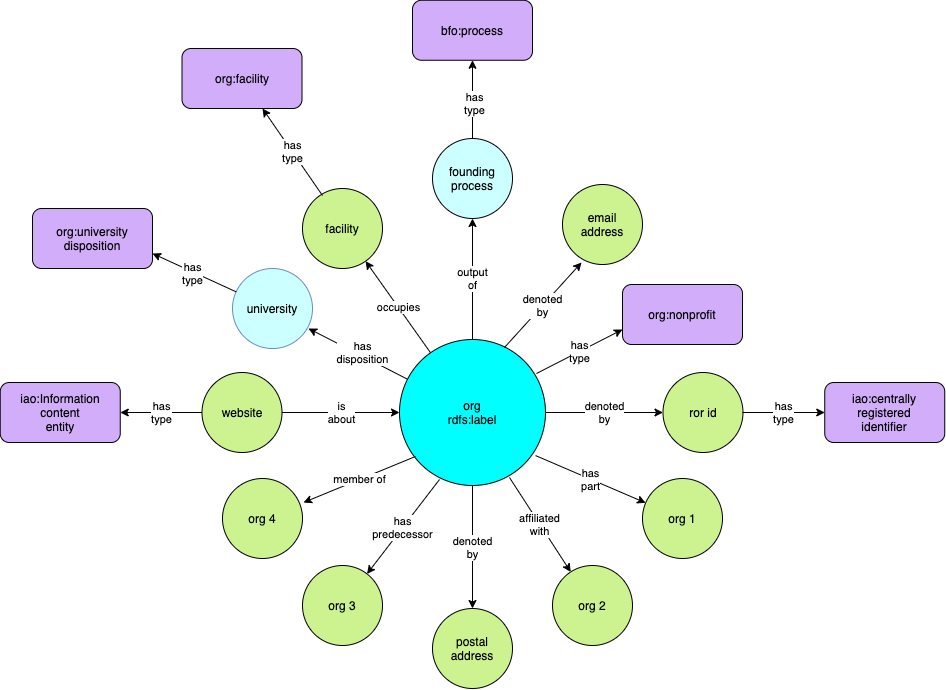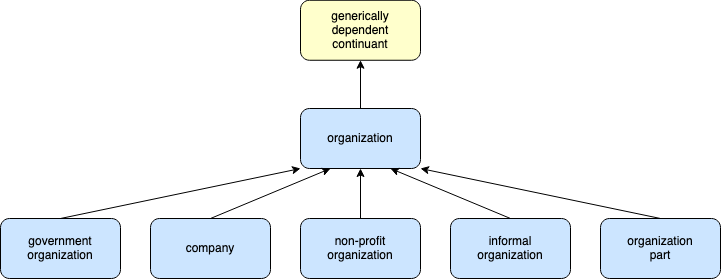Organizations¶
An organization is any collection of people with a purpose. Organizations may be formal/legal, as in the case of universities and corporations, or they may be informal, as, for example, clubs. Organizations may be parts of other organizations.
Subsumption¶
Organizations are generically dependent continuants 1 since they depend on the people and documents which define them. All the people and documents may be replaced with other people and documents, and the organization continues to exist.
Overview¶
Figure 1 shows the classes and properties used to represent organizations in ORG. An overview of the classes and properties follows the figure.

Figure 1. Representation of organizations. The organization of interest is at the center of the figure. See notes below.¶
At the center of the figure note that an organization has a name (rdfs:label).
An organization has a type. In the figure, the type of the organization is org:nonprofit. See below for a further discussion of types.
Now proceeding clockwise from type:
An organization may be denoted by one or more identifiers. Identifiers are represented using the Identifier Ontology (IDO). Note that the identifier is an entity. It exists independently of the organization to denotes.
Orgs may be related to other orgs. An org may be part of another organization.
An org may be affiliated with another organization.
An org may be denoted by a postal address. See Addresses for details. Addresses have properties that indicate how they are to be used.
An org may have a predecessor organization. Organizations undergo change. The resulting organization may be a new organization of a different type, different people, different purpose.
An organization may be a member of another organization.
Organizations often have web sites. Web sites are information content entities that are about the organization. Note that the web site is an entity that exists with or without the organization it is about.
Organizations have one or more dispositions. Dispositions identify the purpose of an organization. Dispositions of an organization may change over time. See below for a further discussion of dispositions. A disposition is dependent the entity which has the disposition. In BFO, a disposition is a specifically dependent continuant, dependent on the entity which has the specific disposition.
An org may occupy zero or more facilities, such as an office building, or university campus. A facility is typically a man-made structure attached to the ground. As such, facilities have geographical locations – in cities, for example. See Facilities for more detail.
Organizations come into being as the result of founding processes which have associated dates. See Dates and Times for a further discussion of the representation of dates and times related to organizations.
Organizations may be denoted by one or more email addresses. See Addresses for details. As with postal addresses, email addresses may have properties describing their purpose.
Types¶
Organizations have one of the types in the table below. These are mutually exclusive. An organization can not be more than one type, just as an animal cannot be more than one species.
See Table 1.
Term ID - Label |
Definition |
|---|---|
An organization which is the body of persons that constitutes the governing authority of a political unit |
|
A legal entity of associated persons created for a specific purpose, typically commercial, in which excess revenue may be distributed to the company’s owners. |
|
A legal entity of associated persons created for a specific purpose, typically a mission, in which excess revenue is reinvested to serve the entity’s mission |
|
A group of people recognized as such by people outside the group. Without legal standing. |
|
An organization which exists as part of another organization. Implies a part_of relationship to another organization |
Figure 2. Subclasses of organization and subsumption hierarchy. The subclasses are mutually exclusive. shows the subsumption hierarchy for organization and its subclasses.

Figure 2. Subclasses of organization and subsumption hierarchy. The subclasses are mutually exclusive.¶
Dispositions¶
Organizations have dispositions which indicate the purposes organizations have. An organization might have a disposition of library or healthcare or military. Dispositions are shown in Table 2 Dispositions An organization may have any number of dispositions.
See Table 2.
Term ID - Label |
Definition |
|---|---|
A disposition to award academic degrees and conduct research in a variety of academic disciplines |
|
A disposition to organize organizations or individuals along and industry or academic lines |
|
A disposition to organize organizations along industry or academic lines |
|
A disposition to provide service with or without a fee |
|
A disposition to provide laboratory services. In the US, organization parts in universities that have a disposition to provide laboratory services to others are called core laboratories |
|
A disposition to provide extension services, typically in agriculture. Extension provides access to university research findings and advice to agriculturalists. |
|
A disposition to create licenses for intellectual property for use by these beyond the creators |
|
A disposition to donate charitable causes, sometimes in the form of grants involving contracts regarding the use of the donated funds or effort. |
|
A disposition to fund proposals, often is response to a call for proposals by the entity with the funding disposition |
|
A disposition to collect, store, and provide access to inanimate material entities, and/or information content entitites |
|
A disposition to collect, store, and provide access to inanimate material entities in a facility |
|
A disposition to display collected works from an archive |
|
A disposition to publish information content entities |
|
A disposition to conduct research |
|
A disposition to teach, and provide experiential opprtunities for students |
|
A disposition to train, and provide experiential opportunities for trainees |
|
A disposition to provide resources and oversight for those conducting research |
|
A disposition to provide library services |
|
A disposition to sell things |
|
A disposition to engage in warfare |
|
A disposition to engage in matters of spirtuality and faith |
|
A disposition to provide governance |
|
A dispositon to construct material entities |
|
A disposition to execute and finish a project. |
|
A disposition to engage in sports activites, typically competitive. |
|
The disposition of an organization that operates airplanes carrying frieght or passengers |
|
The disposition of an organization that creates, transmits, and/or licenses live or recorded material for viewing by others |
|
The disposition of an organization to perform live or recorded music, theatre, or dance |
|
The disposition of an organization to organize workers for the purpose of negotiations with employers of the workers |
|
The disposition of an organization part to serve as an academic department, with faculty, courses, programs, focused on an academic discipline |
|
The disposition of an organization part to serve as an academic college, with academic departments organized within it as parts |
|
The disposition of an organization part to serve as a a body of persons delegated to consider, investigate, take action on, or report on some matter |
|
The disposition of an organization to provide education for very young children, varying by jurisdiction, but often in the age range 2-5 |
|
The disposition of an organization to provide education for young children, varying by jurisdiction, but often in the age range 5-11 |
|
The disposition of an organization to provide education for children, varying by jurisdiction, but often in the age range 11-14 |
|
The disposition of an organization to provide education for older children, varying by jurisdiction, but often in the age range 14-18 |
Examples¶
Duke University
Duke is a nonprofit organization with a dispositions of university, education, and research
Duke has an organization part, Duke Health, which has a disposition of healthcare. Duke Health has an organizational part, Duke University Hospital, which has a disposition of hospital.
United States Navy
The United States Navy is an organization part of the US Department of Defense with disposition of military.
BASF
BASF is a company with a disposition of commerce.
Qualities¶
Qualities are realized entities that do not require a process, and can be added or subtracted from an entity without altering the entity. Use the has quality property to associate a quality with an entity.
For example, to assert organization x is student-led:
x has_quality y
y a student_led_organization_quality
See Table 3.
Term ID - Label |
Definition |
|---|---|
A quality of an address to be used for information inquiries |
|
A quality of an address to be used to receive bills |
|
A quality of an address to be used to receive shipped goods |
|
A quality of an address to be displayed in most settings |
|
A quality to be the primary website for an entity. |
|
A quality to be the webpage within WikiPedia regarding the entity |
|
The quality of an organization that is led by a student |
|
The quality of an organization that is led by a woman |
|
The quality of an organiztion that is led by a designated minority |
|
The quality of a location that is the legal/registered location for the organization |
|
The quality of a location that is the primary/preferred location for the organization |
|
The disposition of an organization to be in current existence and currently operational |
|
The disposition of an organization to no longer exist, or to be currently devoid of operations |
Footnotes
- 1
By OBO-complaint, we mean the ORG ontology has been developed in accordance with Open Biomedical Ontologies (OBO) Principles.
- 2
The OBO community is having an on-going conversation about the subsumption of organization. OBI defines organization as a material entity. The VIVO Project disagrees with this assertion, as organizations can not be weighed, put in a box, or otherwise measured as material entities. Their generic reliance on people and documents/understandings of purpose seems to indicate that they are generically dependent on these components.